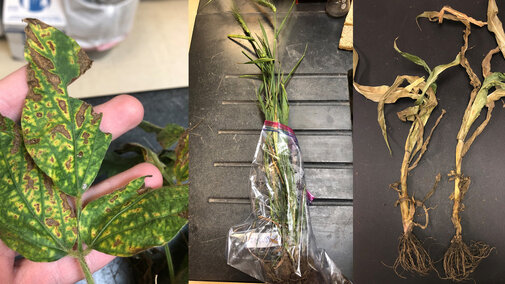As the growing season continues, the Plant and Pest Diagnostic Clinic is here to serve Nebraska growers for correctly identify weeds, insects and plant diseases. Herbicide injury is only diagnosed using visual symptoms; we are unable to do residue analysis.

Visitors and walk-ins are welcome to bring in samples at the PPDC in Lincoln and the Panhandle Plant Disease Diagnostic Lab in Scottsbluff. On East Campus, building access is restricted with only a few doors being open — please access Plant Science Hall through doors on the east and west sides. We also have a cooler available to drop samples at both Plant Science Hall and a smaller drop box located at Entomology hall for any insect questions. The PPDC dropbox has been moved to the east side of Plant Science Hall to make it easier to find.
As always, Quality Samples Lead to Better Diagnosis, and we have a few more tips in order to make sure that our diagnosticians and extension specialists are getting the samples in a timely manner. More information on sample submission may be found here.
- Plant Science Hall Dropbox Location: Outside of the east, first floor door to Plant Science Hall at the loading dock.
- Physical address is 1875 N. 38th St., Lincoln, Nebraska
- Entomology Hall Dropbox Location: Outside of west entrance to Entomology Hall. When facing the main doors, sample box is on the left side of the entryway. Please label sample with name and contact information.
- Physical address is 1700 E. Campus Mall, Lincoln, Nebraska
- Please contact either Kyle Broderick, Kyle Koch, or call (402) 472-2559 when samples are dropped off to ensure quick pick-up.
- A staff member would be happy to meet to collect oversized samples if prior arrangements are made for collection.
- Drop boxes will be checked periodically Monday-Friday, but not over the weekend unless prior arrangements are made.

Producers can also email the PPDC for general questions. Additionally, mobile images may be texted to (402) 641-1273. While identification of plant diseases and insects may not be 100% accurate from a photo, we will identify what we can. If sending images for diagnosis, here are a few tips:
Tips for Submitting Plant Disease Photos for Identification
- Include close-up pictures of injury/lesions, pictures of the entire plant part (leaves, stem, roots), and pictures of the entire plant.
- For mushrooms, include pictures of the top and bottom of the cap, the stem and whole mushroom. Include a size reference such as a coin or ruler.
- Avoid using the zoom function when taking the picture on cell phone cameras; instead, get as close to the subject as possible. If your camera has a “macro” mode, use it — it allows you to focus much closer on the subject.
- Focus carefully to make sure the specimen is clear.
- Take pictures in full light as shadows may obscure the specimen. Use light that accurately depicts what you are seeing (this may mean different angles and locations).
- Take multiple pictures and send in the best five.
- Include as much information as you can about what you are seeing: Describe injury/lesions, when they first started to appear, and any information you deem relevant about the plant.
Tips for Submitting Insect Photos for Identification
- If possible, fill the frame with the insect. Avoid using the zoom function when taking the picture on cell phone cameras; instead, get as close to the subject as possible. If your camera has a “macro” mode, use it — it allows you to focus much closer on the subject.
- Take the photos in well a lit room or outdoors (indirect sunlight). If you cannot get into a well-lit area, make sure the flash is turned on. In low light settings, the camera will use a slower shutter speed (unless using the flash). Slower shutter speeds usually result in blurrier images.
- Focus carefully and rest your elbows or hands on a solid surface rather than trying to hold the camera unsupported, if possible. This will also help reduce camera shake to get a sharper image.
- Take multiple pictures and select the best two or three to send. In addition, take photos of multiple aspects (the top, side and bottom) if possible. Sometimes important features are only visible on the side or bottom of a specimen.
- Include a size reference, such as a ruler, next to the specimen in the photograph. A coin, pencil, etc. will also work.
- Include as much information as you can about the insect: Where are you finding them, how many, what kind of injury are they causing, etc.

